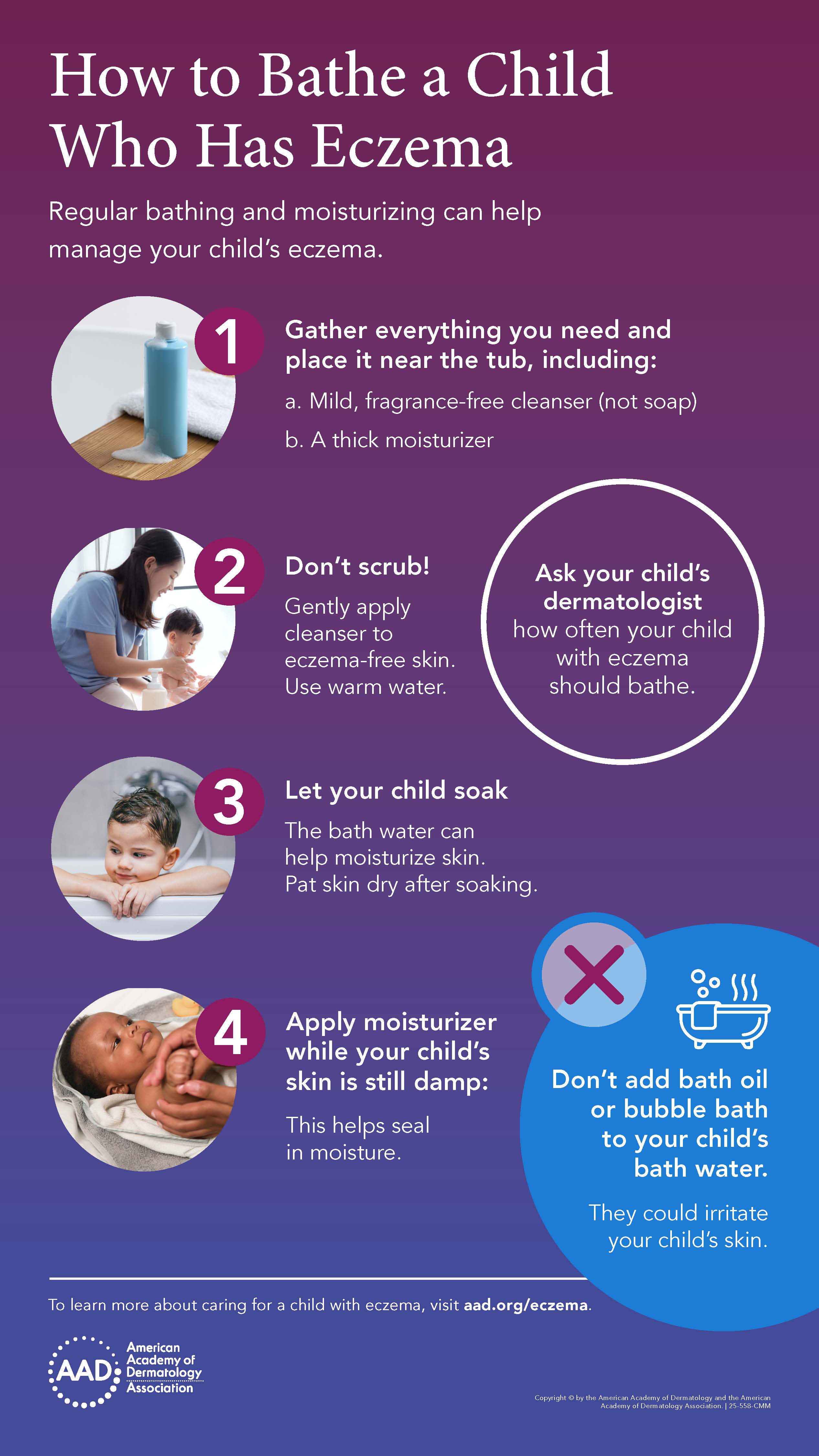Home remedies: What can relieve itchy eczema?
If you’ve tried numerous remedies and nothing seems to stop the itch, you’re not alone.
Parents often tell dermatologists that nothing they try seems to stop the itch. Research shows that the best way to relieve itchy eczema is to get eczema under control. This can take time.
In the interim, dermatologists recommend the following, which can bring some immediate — but temporary — relief from the itch.
Oatmeal bath
Adding colloidal oatmeal to your child’s bath can help relieve dry, itchy skin.

6 ways to relieve itchy eczema at home
Apply a cool compress to itchy skin. To use this technique, you:
- Soak a clean towel or washcloth in cool water.
- Wring the towel or washcloth until damp.
- Apply the cool compress to the itchy skin.
- After removing the compress, apply your child’s moisturizer to the skin you just treated with the compress.
Telling your child to stop scratching itchy skin rarely works.
Eczema is just too itchy, and telling your child to stop scratching can feel stressful. Stress often makes eczema worse.
Add colloidal oatmeal to your child’s bath. You’ll find colloidal oatmeal at many places that sell health and beauty products. When you add this to your child’s bath, it helps relieve the dry, itchy skin.
When using colloidal oatmeal, dermatologists recommend:
- Add the colloidal oatmeal to the running lukewarm water.
- Let your child soak for 10 to 15 minutes.
- After the bath, gently dry your child, leaving enough water on the skin so that it feels damp.
- Apply your child’s moisturizer within 3 minutes of bathing.
Safety tips
Don’t let your child eat the finely ground oatmeal.
Colloidal oatmeal makes the bath very slippery, so take care to prevent a slip or fall.
Soak in a bath and smear on ointment. After letting your child soak in a lukewarm bath, smear a thick layer of moisturizing ointment on all of your child’s skin. When the skin is very itchy, using an eczema friendly ointment like petroleum jelly provides more relief than a cream or lotion.

Follow these dermatologist tips to help manage your child's eczema with regular bathing and moisturizing. Click the image above to download the PDF. Distract your child. Helping your child forget about the itch can be effective. Be sure not to mention the itch, just distract your child with a favorite activity. You can:
- Play peek-a-boo
- Feed your child a snack
- Play with a toy
- Tell a story
Calm a stressed child. Research shows that stress can cause eczema to flare. Stress can also make skin itchier. If you feel stressed, your child often feels stressed. It’s important to find ways to reduce your stress, too.
Pinch skin near patch of itchy eczema. Yes, a gentle pinch can actually reduce the itch. Just be sure to pinch skin without eczema.
For teens and tweens: Children who are caring for their own skin can gently tap near the itchy eczema. Sounds odd, but this help reduce the itch.
2 surprising ways parents make eczema itchier
Some itch-relieving techniques that people use can make eczema itchier. To prevent this, dermatologists recommend that you avoid:
Telling your child to stop scratching: This rarely works and can leave your child feeling stressed. Stress can cause eczema to flare.
Using anti-itch products: This may seem strange, but anti-itch products often fail to relieve itchy eczema. To make matters worse, some contain ingredients that can cause eczema to flare. Only use an anti-itch product if your child’s dermatologist recommends one.
Prevent skin damage caused by scratching
Constant scratching can break the skin. To prevent bleeding and an infection, dermatologists recommend the following:
Keep your child's nails short: Checking nails after your child's bath lets you know when the nails need trimming.
Cover itchy skin: When skin is covered, children seem less likely to scratch. When dressing your child, be sure to:
Dress your child in lose-fitting clothes made from a soft, natural fiber-like cotton, a cotton blend, silk, or bamboo.
Consider using eczema mittens and eczema sleeves.
Eczema mittens can be effective when eczema flares on your baby's face. Your baby may still scratch, but the scratching will cause less damage because the fingernails cannot dig into the skin.
Itch relief can be fickle
You may find that a technique works one day and not the next. If one technique fails, try another.
Related AAD resources
References
Eichenfield, LF, Tom WL, et al. “Part 2: Guidelines of care for the management and treatment of atopic dermatitis with topical therapies.” J Am Acad Dermatol. 2014 Jul;71(1):116-32.
Sidbury R, Tom WL, et al. “Part 4: Guidelines of care for the management of atopic dermatitis. Part 4: Prevention of disease flares and use of adjunctive therapies and approaches.” J Am Acad Dermatol. 2014: 71(1);1218-33.
 Atopic dermatitis: More FDA-approved treatments
Atopic dermatitis: More FDA-approved treatments
 Biosimilars: 14 FAQs
Biosimilars: 14 FAQs
 How to trim your nails
How to trim your nails
 Relieve uncontrollably itchy skin
Relieve uncontrollably itchy skin
 Fade dark spots
Fade dark spots
 Untreatable razor bumps or acne?
Untreatable razor bumps or acne?
 Tattoo removal
Tattoo removal
 Scar treatment
Scar treatment
 Free materials to help raise skin cancer awareness
Free materials to help raise skin cancer awareness
 Dermatologist-approved lesson plans, activities you can use
Dermatologist-approved lesson plans, activities you can use
 Find a Dermatologist
Find a Dermatologist
 What is a dermatologist?
What is a dermatologist?
